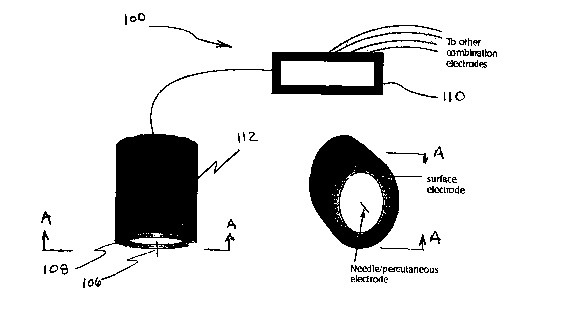Some of the information on this Web page has been provided by external sources. The Government of Canada is not responsible for the accuracy, reliability or currency of the information supplied by external sources. Users wishing to rely upon this information should consult directly with the source of the information. Content provided by external sources is not subject to official languages, privacy and accessibility requirements.
Any discrepancies in the text and image of the Claims and Abstract are due to differing posting times. Text of the Claims and Abstract are posted:
| (12) Patent Application: | (11) CA 2496879 |
|---|---|
| (54) English Title: | COMBINED PERCUTANEOUS/SURFACE ELECTRICAL STIMULATION |
| (54) French Title: | STIMULATION ELECTRIQUE PERCUTANEE ET DE SURFACE COMBINEE |
| Status: | Deemed Abandoned and Beyond the Period of Reinstatement - Pending Response to Notice of Disregarded Communication |
| (51) International Patent Classification (IPC): |
|
|---|---|
| (72) Inventors : |
|
| (73) Owners : |
|
| (71) Applicants : |
|
| (74) Agent: | KIRBY EADES GALE BAKER |
| (74) Associate agent: | |
| (45) Issued: | |
| (86) PCT Filing Date: | 2003-09-02 |
| (87) Open to Public Inspection: | 2004-03-11 |
| Examination requested: | 2007-06-26 |
| Availability of licence: | N/A |
| Dedicated to the Public: | N/A |
| (25) Language of filing: | English |
| Patent Cooperation Treaty (PCT): | Yes |
|---|---|
| (86) PCT Filing Number: | PCT/US2003/027343 |
| (87) International Publication Number: | US2003027343 |
| (85) National Entry: | 2005-02-25 |
| (30) Application Priority Data: | ||||||
|---|---|---|---|---|---|---|
|
A combined percutaneous/transcutaneous stimulator (110) using integrated
surface electrodes (112) delivers electric pulses simultaneously to deep
tissue and a skin surface of a target area.
L'invention concerne un stimulateur et un procédé de stimulation électrique intégrée d'un muscle, de nerfs et de tissus. Un stimulateur combiné percutané/transcutané utilisant des électrodes de surface intégrées délivre des impulsions électriques simultanément aux tissus en profondeur et sur la surface de peau d'une zone cible. Les électrodes de surface intégrées comprennent une électrode à aiguille fine intégrée à l'électrode de surface. Le stimulateur combiné percutané/transcutané doté des électrodes de surface intégrées apporte un soulagement rapide de la douleur, une insertion plus confortable d'insertion d'électrode à aiguille et des résultats de réduction de la douleur de plus longue durée.
Note: Claims are shown in the official language in which they were submitted.
Note: Descriptions are shown in the official language in which they were submitted.

2024-08-01:As part of the Next Generation Patents (NGP) transition, the Canadian Patents Database (CPD) now contains a more detailed Event History, which replicates the Event Log of our new back-office solution.
Please note that "Inactive:" events refers to events no longer in use in our new back-office solution.
For a clearer understanding of the status of the application/patent presented on this page, the site Disclaimer , as well as the definitions for Patent , Event History , Maintenance Fee and Payment History should be consulted.
| Description | Date |
|---|---|
| Application Not Reinstated by Deadline | 2009-09-02 |
| Time Limit for Reversal Expired | 2009-09-02 |
| Deemed Abandoned - Failure to Respond to Maintenance Fee Notice | 2008-09-02 |
| Letter Sent | 2007-08-16 |
| Amendment Received - Voluntary Amendment | 2007-06-26 |
| Request for Examination Requirements Determined Compliant | 2007-06-26 |
| All Requirements for Examination Determined Compliant | 2007-06-26 |
| Request for Examination Received | 2007-06-26 |
| Inactive: Office letter | 2006-12-27 |
| Letter Sent | 2006-03-29 |
| Inactive: Single transfer | 2006-02-21 |
| Inactive: Correspondence - Formalities | 2005-08-16 |
| Inactive: Cover page published | 2005-05-06 |
| Inactive: Courtesy letter - Evidence | 2005-05-03 |
| Inactive: Notice - National entry - No RFE | 2005-05-02 |
| Application Received - PCT | 2005-03-16 |
| National Entry Requirements Determined Compliant | 2005-02-25 |
| Application Published (Open to Public Inspection) | 2004-03-11 |
| Abandonment Date | Reason | Reinstatement Date |
|---|---|---|
| 2008-09-02 |
The last payment was received on 2007-06-21
Note : If the full payment has not been received on or before the date indicated, a further fee may be required which may be one of the following
Patent fees are adjusted on the 1st of January every year. The amounts above are the current amounts if received by December 31 of the current year.
Please refer to the CIPO
Patent Fees
web page to see all current fee amounts.
| Fee Type | Anniversary Year | Due Date | Paid Date |
|---|---|---|---|
| Registration of a document | 2005-02-25 | ||
| Basic national fee - standard | 2005-02-25 | ||
| MF (application, 2nd anniv.) - standard | 02 | 2005-09-02 | 2005-06-23 |
| MF (application, 3rd anniv.) - standard | 03 | 2006-09-05 | 2006-06-23 |
| MF (application, 4th anniv.) - standard | 04 | 2007-09-04 | 2007-06-21 |
| Request for examination - standard | 2007-06-26 |
Note: Records showing the ownership history in alphabetical order.
| Current Owners on Record |
|---|
| INTERNATIONAL REHABILITATIVE SCIENCES, INC. |
| Past Owners on Record |
|---|
| RICHARD M. TERRELL |
| WILLIAM J. CARROLL |